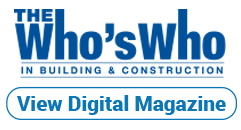Constructing Strategic Experiences
Concord General Contracting, Inc.’s vision focuses on ‘ultimate’ client and employee experiences

Concord General Contracting, Inc. team members are shown during a grand opening ceremony for the corporate headquarters of Roosevelt Water Conservation District in Mesa, AZ. Left to right: Project Manager Matt Beaver; Superintendent Chris LaCour; CEO Grenee Celuch and Director of Operations Bob Cashin.

Concord General Contracting, Inc.’s renovation of the Tucson Convention Center in Tucson, AZ, was a $10 million project completed in 2015.
From its very name and redesigned logo and tagline (“Building Collaboration”), to its unique customer experiences and in-house culture, Concord General Contracting, Inc. (Concord), with operations in Mesa and Tucson, Arizona, practices what it preaches.
Rather than naming the company after themselves, the original owners Jim and Gary Jackson in 1972 chose Concord, which means unity. “Forty-eight years later, we’ve remained true to that as our team works in collaboration with each other and our clients,” says CEO Grenee Celuch.
A lot, however, has changed. For starters, the company has a strategic plan, something it couldn’t claim until its continuous planning efforts began in 2011, while Celuch, who joined Concord in 2007, was Director of Marketing before being named CEO in 2016. Then came a rebranding effort in 2018, resulting in a new logo and messaging. And this past August, the company transitioned to an employee stock ownership plan (ESOP) and is now 30% owned by employees and 70% by a five-person leadership team that includes Celuch as well as JV Nyman, President; Jason Beaver, Chief Operations Officer; John Nyman, Shareholder/Director of Estimating; and Dale Marr, Shareholder.
Engage, Build and Deliver
Much of Concord’s strategic planning and rebranding efforts have helped define its client targets and core values. Its clients include school districts, municipalities, nonprofit organizations and churches. The company’s core values include engaging and collaborating with clients, building quality and innovative projects and delivering “the ultimate in customer experiences,” Celuch says. These include on-the-job innovations, site dedications and groundbreakings, and even construction-based curriculum for students attending Concord-constructed schools.
Citing several examples, Beaver, a 17-year employee, leads with the historic 1890s-era Pinal County Courthouse in Florence, Arizona, now used for municipal offices. The $7 million, six-month project “wasn’t an easy one,” he says. “It had been vacant for five years and had gone through multiple renovations that stripped it of its historic character.” Concord brought in a window replicator to achieve energy-efficient and historically reminiscent windows, used interior bricks from wall demolitions to restore the badly worn building exterior and installed a cost-saving elevator—cost-saving because of Concord’s commitment to the customer experience.
“Plans called for a custom $150,000 elevator housed in a curved wall,” Beaver explains. “By reorienting the elevator and moving it 3 feet, we opened enough space for a standard-sized elevator. We collaborated with the architect and with his blessing took it to the county for its approval.” The end result: “We saved the client $75,000 and the project won an American Public Works Association award.”
Another standout Concord client experience: the University of Arizona’s Hillenbrand Memorial (softball) Stadium, a $10 million, seven-month project. “This was such a fast-moving project that there were times when we were building as the architect was completing drawings,” Beaver recalls. “We installed modern lounges, mezzanine and VIP sections, concession and ticket areas, an elevator and, for the first time, restrooms in the dugouts, all the while keeping the field in play for practices and games. What we were able to accomplish made a huge difference in terms of the fan/player experience.”
Perhaps the best example of delivering on the client-experience promise isn’t a building innovation, though it certainly could lead to myriad innovations 10 or 20 years from now. Rather, this exceptional case has to do with classroom learning.
“The former director of facilities for the Tempe (Arizona) Elementary School District, a longtime Concord client with multiple building projects, asked for our help in developing a curriculum to teach students, grades four to eight construction basics with Concord team member serving as instructors,” Beaver explains. “Many of the students have parents or family members in the construction industry, so it makes sense from an educational standpoint to introduce them to the construction process—from preconstruction and budgeting to masonry and electrical.”
While this educational effort—which builds upon Concord’s longstanding commitment to what it calls “Construction Days” learning events— began in 2014 and continues today, each curriculum is customized annually based on student need and interest. “We work closely with the teachers, district curriculum personnel and the principals,” Beaver says, “to develop programs that meet their educational goals.”
Better Branding
Such efforts align with the company’s tagline—”Building Collaboration”—a result of its 2018 rebranding effort.
“We interviewed our clients to help determine how we were perceived,” Celuch says. “The biggest takeaway: We are thought of as a collaborative group. Yet our messaging and logo didn’t reflect that.”
So, Concord and TankGirl Marketing in Phoenix teamed up to develop a large teal-colored C. “Teal,” Celuch says, “because the color is soothing and reflects our business approach, which revolves around building relationships.” Moreover, the letter’s open space is partially filled with a dark gray curve, serving as a bridge between the top and bottom ends of the C. “Our logo and tagline help set us apart and communicate unity in what we do,” she adds.
As for the messaging, Celuch says, “There really wasn’t any that showed who and what we are.” Which is? “We’re problem-solvers who aren’t just about building buildings.” Or, as the company’s website proclaims: At the end of the day it’s not about the project, it’s about the experience.
Elevating Employees
This same commitment to ensuring a positive experience extends to employees as well as clients, as Concord’s workplace culture is said to be a deliberate result of careful hiring practices, team-building events and benefits that help ensure the financial and physical well-being of its 55 employees (Mesa: 40; Tucson: 15).
“Every company has its culture,” says Celuch, “and ours is one that’s very team-oriented, with employees pitching in and wearing multiple hats wherever and whenever necessary and thriving without being micromanaged. We work hard and like to have fun, and we look for those traits when hiring new team members.”
“Competitve pay and benefits, including multiple health care options, gym memberships, flexible work hours and 18 annual PTO (personal time off) hours per employee for charitable work, coupled with our reputation for having a progressive company culture, draws new employees to our company,” Beaver adds.
Concord even has its own “culture committee,” consisting of field personnel and office staff, “and no one from the leadership team,” Celuch says. Its purpose: communicate important information to employees and plan events that foster camaraderie.
Lately, Concord’s transition over to the ESOP world has been its focus, using a blend of employee meetings and internal communications to educate the team and culminating with a “virtual party” because certain members of the office staff were working remotely during the coronavirus pandemic. Employees received celebration boxes with mini bottles of sparkling wine, ESOP T-shirts and played virtual games.
“Becoming an ESOP company and the accompanying celebration, to me, was Concord’s proudest moment in its 48-year history,” Celuch affirms.


 Login / Register
Login / Register

